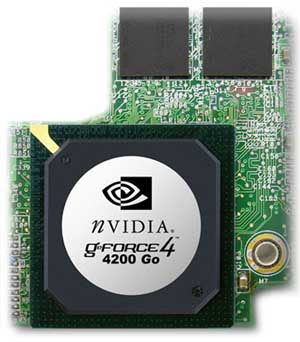NVIDIA GeForce4 4200 Go: Bringing mobile gaming to new heights
by Matthew Witheiler on November 14, 2002 9:00 AM EST- Posted in
- Laptops
The NV28M
What exactly is the NV28M chip that powers the GeForce4 4200 Go? Well, to find the answer one need not look further than the desktop GeForce4 Ti 4200 AGP 8x, the first desktop product from NVIDIA to use the updated NV28 core.
The mobile NV28M chip is based on the desktop NV28 chip which is based on the desktop NV25 chip. Confused yet? We thought so. Let's go through the steps that produced the NV28M.
The first chip in the evolution which created the NV28M was the NV25. Launched nine months ago, the NV25 core is the chip that powers NVIDIA's enthusiast level GeForce4 Ti series chips. At the time, the NV25 core provided a marked improvement over the aged NV20 (GeForce3) core. On top of using a 0.15 micon architecture, the NV25 implemented a number of new features that further pushed the power of 3D graphics accelerators. For one, the NV25 improved upon the NV20's DirectX 8.1 functionality by implementing dual vertex shader units, an addition which helps games that use vertex shading operations run more smoothly.
Except for the addition of the second vertex shader unit, the 3D pipeline of the NV25 remained very similar to that of the older NV20. The NV25 contained the same single pixel shader unit and 4 pixel pipelines capable of processing two textures per pixel. The other hardware upgrade was made not to the 3D pipeline but rather to the memory architecture. The NV25 was the first NVIDIA chip to implement what is known as Lightspeed Memory Architecture II. You can read up on the details of this technology in our initial GeForce4 Ti review, but in summary LMA II effectively increases memory bandwidth offered by managing the data traveling over the memory bus more efficiently.
So that is a brief summary of what went into the NV25, the chip that is found in all GeForce4 Ti 4200, GeForce4 Ti 4400, and GeForce4 Ti 4600 cards out on the market today. In what ways is this chip, the NV25, different from the NV28 used in the GeForce4 Ti 4200 AGP 8x (and perhaps future NVIDIA products)? Not many.
Hardware wise, the NV25 differs from the NV28 in only one way: the NV28 includes an AGP 8x host interface. The NV28 maintains the same 3D pipeline, the same memory controller, and the 2D components. It is easy to see why many were disappointed with the release of the NV28. On the hardware side, there is very little difference between the new NV28 and the existing NV25. On the performance side, the NV28 gains no tangible performance by moving from an AGP 4x design to an AGP 8x one. So does that leave the NV28 without promise. Not exactly.
First off, NVIDIA has only released the GeForce4 Ti 4200 in AGP 8x form. There is no question that both the GeForce4 Ti 4400 and GeForce4 Ti 4600 will receive this chip eventually. Many hope that these incarnations of the NV28 will prove to be more attractive than the current GeForce4 Ti 4200 AGP 8x. But NVIDIA did not see the potential for the NV28 limited to the desktop market. Enter the NV28M.











0 Comments
View All Comments